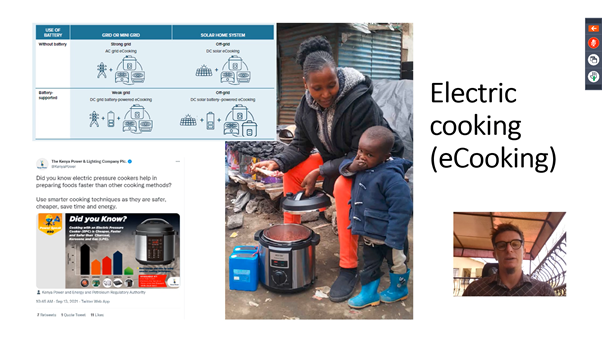
- Date
- 5th October 2021
- Categories
By Iwona Bisaga and Joni Cook (Loughborough University).
On September 24th 2021, GIZ (ESDS and EnDev) in collaboration with UNHCR, GPA and MECS held the second webinar in a series on clean cooking in displacement settings. Following the first webinar on the landscape of stakeholders and solutions, this event provided a snapshot of existing cooking fuels and technologies. Over 100 people from across different regions and sectors participated in the webinar, including public, private, NGO and academia.
After a foreword by Christa Roth, a consultant working on clean cooking in various settings and regions who reminded the attendees that not cooking is not an option for anyone, including in settings such as refugee camps, six expert presenters offered ‘pitches’ on the different fuel and cooking technologies:
- Firewood (Neha Juneja from GreenWay)
- Processed biomass (Matthew Owen from Kikenni Consulting)
- LPG (Hanaan Marwah from Circle Gas)
- E-cooking (Dr Jon Leary from Modern Energy Cooking Services (MECS) programme)
- Biogas (Esther Altorfer from Sistema.bio)
- Ethanol (Desalegn Getaneh from Project Gaia)
In the first half of the webinar, the pitches offered insight into the different aspects of each cooking fuel and technology, including health and safety, environmental impacts and efficiency, affordability, availability, and convenience. Each fuel and technology comes with its own challenges and opportunities. For example, firewood can often be collected for free, which eliminates the cost barrier, but it is harmful for the environment, contributes to forest degradation and, ultimately, to deforestation. Processed biomass solutions are difficult to established in displacement settings due to the very top-down procurement approaches which can be prohibitive. LPG can be cheaper than other, traditional fuels such as charcoal, but is fossil fuel derived and supply chains can be weak, particularly in remote locations. E-cooking (cooking with electricity) might pose challenges around the suitability of energy efficient appliances, such as electric pressure cookers (EPCs), for the types of foods cooked in any given location, but it offers cooking with virtually no emissions and significant time saving due to the speed of cooking and little to no supervision needed. It does, however, require electricity access (either AC or DC) which is often challenging in displacement settings. Biogas is a clean fuel which can be used for both cooking and lighting. Users can benefit from a fertiliser for farming but can also face challenges associated with the amount of feedstock available, which can compromise the effectiveness of biodigesters. Finally, ethanol is another cooking fuel which creates no pollutants, but building sustainable supply chains for ethanol in displacement settings has been proven challenging in locations where it has been introduced, e.g., in Ethiopia.

Interestingly, when asked about the future of clean cooking technology and which fuel is the one that will matter the most, 61% of participants selected e-cooking, whereas firewood jointly with processed biomass, and LPG both received 37% of the votes. This is a promising outlook for modern energy cooking in displacement contexts. To the question on the most important factor in selecting the appropriate cooking fuel and technology, close to 60% chose affordability, with applicability and availability not far behind.

In the second half of the webinar, the group split into 6 breakout rooms, each corresponding to the cooking type covered in the pitches to dive deeper into the advantages and disadvantages of each, and to gain the opportunity to ask questions to the expert presenters. In the breakout room with Dr Jon Leary, a vibrant discussion on e-cooking took place. Of interest to the participants were issues around cultural appropriateness of electric cooking appliances given the cooking practices and types of foods cooked, as well as technical considerations, e.g., how much power is consumed by various e-cooking appliances, and especially EPCs, and whether and how they might be incorporated into off-grid contexts. Mini-grids, powered by solar or any other technology, are one opportunity for e-cooking, but Jon also highlighted that increasingly standalone solar installations, such as Solar Home Systems, will become more suitable as the energy storage capacity increases while the overall prices of solar systems continue to fall. Operational and maintenance issues were also discussed as these are critical to ensure longevity and sustainability of such solutions yet might not be readily available in such settings.
The LPG room participants discussed the challenges and opportunities relating to the use of LPG as a cooking solution in displacement settings. The challenges discussed included the behavioural change shift required to convince potential end users to transition from cooking with biomass fuels to LPG, and the contexts that LPG may be appropriate for. The main challenges mentioned for converting end users to take up LPG include the upfront costs, lack of information, and health and safety concerns. In terms of contexts appropriate for transition from biomass to LPG in displacement settings, the importance of an enabling environment was highlighted. Factors contributing to this include the presence of an existing LPG market in the host country, with sufficient competition among suppliers, and the existence of a national LPG strategy or stated ambitions. In refugee camps where there is a willingness to pay for LPG, the market is often constrained, therefore there is a need for intervention to develop a market. Dr James Haselip (UNEP DTU Partnership) highlighted a pilot scheme to supply LPG in the Nyarugusu refugee camp, Tanzania, as part of a market creation plan to support the Tanzanian Government’s ambition to scale up the use of LPG across the nation. In the context of the refugee camps in Kigoma, it also addresses the Government’s aim to help reduce deforestation and conflict risk with the local communities surrounding the camps.
The recording of the webinar can be accessed here. The next, and last, session in the webinar series will be held on Tuesday, 9th November 2021, and will cover different delivery models for providing access to clean cooking solutions in displacement settings.